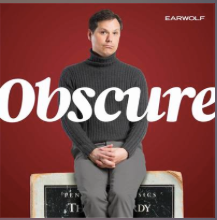I think the universe is telling me to read more Thomas Hardy. I just finished two of his early works, Under the Greenwood Tree and A Pair of Blue Eyes, and I had planned to take a break from Hardy until maybe next year. And then I saw this tweet about a new podcast called Obscure with Michael Ian Black :
Comedian Michael Ian Black is tackling a great work of literature. Actually, Tackling might be too strong a word. More like “light caressing” plus a lot of complaining. He's reading the Thomas Hardy classic, Jude the Obscure, out loud and commenting as he goes. Join Michael, some of his famous (and non-famous) friends and experts as he discovers Jude’s world and a few things about his own. Is it a terrible idea? Probably. But it’s a terrible idea he wants to do with you.
A read-along podcast of a work of classic literature? Sign me up! I've listened to the first episode, which is about half an hour long and is an introduction with Black explaining how the podcast came about, and his reading and commenting on the first chapter (which is very short). I'm also wondering if he's only going to read one chapter a week, which might take almost a year -- by my count, there are 50 chapters in this book. I'm pretty sure I can't stretch out an audiobook of only 400 pages for an entire year -- I tend to get impatient towards the end and just read a print or digital copy.
But I'm definitely interested in listening to a comedian's thoughts and comments on a great work of literature.
So, I've already downloaded a digital audio copy of Jude from library (only a three-week checkout), and listened to the first chapter -- you can definitely tell the difference with a professional reader. Coincidentally, it's the same narrator, Frederick Davidson, who read my previous audiobook (An Old Man's Love). He's an excellent narrator and does all different voices and accents -- it's always a little weird for me to hear an American narrating a British book, so I definitely prefer listening to the book narrated by Davidson. I really enjoyed the first podcast -- Michael Ian Black is a little snarky, but now I'm imagining a whole series of comedians reading and commenting classic literature. Comedians in Cars Discussing Literature, if you will.
You can subscribe for automatic downloads or just listen online. It looks like it's going to be an entire summer of Thomas Hardy for me after all.









